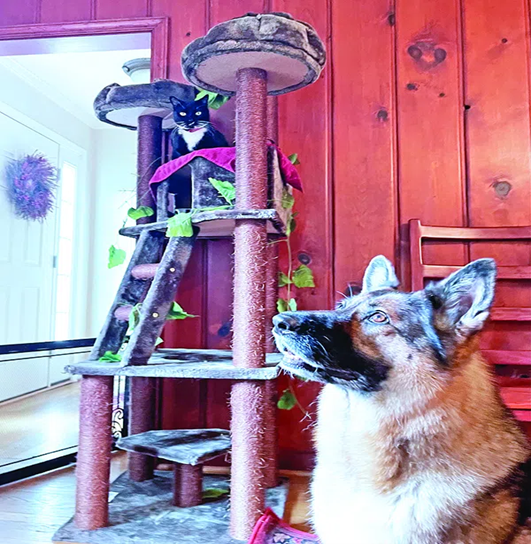By Kathy Callahan, CPDT-KA -Published: November 19, 2021

A very tall cat tree and a well-trained dog help smooth a canine/feline introduction. Our kitty Bo and dog Mojo have been friends for years, but we often host foster dogs, so the tree and the baby gate on the other side of it help give our cat a quick path to safety.
According to family lore, when my husband was a little boy, his bedtime request was always the same: “Tell me a story about a doggy and a kitty who made friends.” Those of us who have navigated the doggy-kitty waters know that he was definitely onto something. This topic has drama, surprise, even a bit of danger – all with the potential for a gleefully happy ending. Luckily, in real life, there’s much you can do to short-circuit the suspense and get to the “happily ever after” as soon as possible.
1. Plan carefully for the first minute and stick to the plan.
If you take away only one thing from this article, make it this: You don’t get a second chance at the first minute.
The time to think about facilitating a good canine-feline introduction is way before you add the new pet. The very first moments in the house together can set the tone for this new dynamic. If you’ve taken a spontaneous, “Oh, they’ll work it out” approach, and the all-but-inevitable giant chase scene takes place, you have already blown it.
That’s so easy to prevent with just a little upfront planning. Remember that you’re going to have a lot on your mind as you enter the house with that new pet. The most frustrating call I get is this one: “Oh, I meant to have the dog in the crate when we came in with the new kitty, but we were so excited we just forgot. There was a chase. Honestly, Rover just wanted to play! He didn’t mean any harm. But, um, Fluffy hasn’t come out from under the bed for two days. What do we do now?” You’ll wish you could get that first hour back.
2. How to introduce a dog to a cat
The new pet in question, whether the dog or the cat, has a lot to take in at first: New people, new home, new vibe. It makes sense to postpone the much-anticipated dog-cat introduction until there’s been time settle in. For example, if a kitty is the newcomer to the home, you may want to keep her in a bedroom for anywhere from an afternoon to a few days as you bond with her.
In some cases, allowing the dog and the cat to sniff each other under a bedroom door can be a perfect start. Without that intense visual stimulus, the interaction is often calmer. You can exchange bedding materials to allow even closer investigation via the nose.
Once the new kid is a bit settled, it’s time for a formal introduction. Ideally, you’ll get a ho-hum reaction along the lines of “Oh, it’s the dude from under the door.”
3. Contain the dog.
There are two keys to the best introductions: canine containment and feline confidence. Think hard about how you can reinforce both at your house.
Typically, a dog is the more excited part of the new duo, which is why that’s the side you’ll want to contain. Please don’t assume the rules are different for a little puppy! People often discount the emotional trauma an exuberant (if physically harmless) puppy can cause. The bottom line is that if you want a dog and a cat to become friends, you’ll start by keeping the dog from getting in the cat’s space.
If your dog is comfortable with a crate, that’s the ideal place for him when he’s first meeting the cat. Alternatively, you can use gates or pens to establish a safe separation. Either option has the advantage of leaving you hands-free and able to move between the pets to manage the situation and deliver treats.
While keeping a dog on leash for the intro might be fine with a completely uninterested dog or the tiniest of puppies, it might be a challenge, and here’s why:
Your hands are occupied with the leash, making it difficult to manage treats or petting.
You get tired of holding on, which could lead to a slip-up.
If you let your leashed dog pull you around after the cat, the cat will feel there’s no place that is dog-free, so her anxiety stays through the roof.
Continue reading: https://www.whole-dog-journal.com/behavior/how-to-get-cats-and-dogs-to-get-along/
